|
“New giant squid predator found”
January 04, 2004, BBC News Online, UK: “A little known shark that lives in waters off Antarctica is only the second creature known to science that hunts giant squid for food.
Sleeper sharks even appear to target the biggest species of large squid – the colossal squid, which is about double the size of the shark.
The huge sperm whale was previously the only animal thought to rely on giant and colossal squid for food. Details of the study are featured in the journal Deep Sea Research.”
[Full Story]
“Watery vision of Grand Canyon”
January 09, 2004, The Guardian, UK: “Noah and his ark have entered the choppy waters of a debate about the age and geological history of the Grand Canyon, one of the world’s greatest tourist attractions.
Geologists estimate that the 217-mile-long canyon in Arizona was fashioned by the Colorado river between 5m and 6m years ago and contains some of the oldest exposed rocks on Earth.
But now a book sold in the Grand Canyon park official bookshop suggests that it was created by the flood reported in Genesis.”
[Full Story]
“Could Dead Sea Anchor Be from Herod’s Royal Yacht?”
January 13, 2004, The Scotsman, Scotland: ” An Israeli archaeologist has discovered what he says is a unique Roman-era wooden anchor on the shores of the Dead Sea, preserved by the water’s high salt and mineral content.
Archaeologist Gideon Hadas said he would like to believe – but has no proof – that the anchor came from a royal yacht of biblical King Herod who ruled Judea at the time of Jesus’ birth and had a palace on nearby Mount Masada.
The 2000-year-old anchor, about six feet tall, was found last month when it was protruding from the banks, revealed by the receding waterline.”
[Full Story]
“Bronze artifacts found off Egypt’s north coast”
January 19, 2004, CTV News, Canada: “A French archaeological team has retrieved more than 1,000 bronze artifacts, including statues and busts of Pharoanic gods and goddesses, from the Mediterranean sea floor off Egypt’s northern coast, Egyptian antiquities officials said Sunday.
The artifacts found during archaeological surveys last month date to the 3rd through 5th centuries B.C., and also include tools and containers used in religious rituals, Mohamed Abdel Maqsoud, a senior official in the Supreme Council of Antiquities said.
The French mission, led by Franck Goddio, has left for Paris, Abdel Maqsoud said, and its members could not immediately be reached for comment.
‘The most impressive and beautiful item is a diorite bust of an unidentified person with long hair, which some believe (could be) the Nile god, Hapy,’ Zahi Hawass, head of the Supreme Council for Antiquities, said in a statement. All of the artifacts have been removed to be cleaned of seawood and salts and be restored, the Supreme Council’s statement said.”
[Full Story]
“City Scientists Say Red-Sea Miracle Can Be Explained”
January 20, 2004, St. Petersburg Times, Russia: “Two Russian mathematicians have attempted to explain the miracle of the parting of the Red Sea, which according to the Old Testament and the Torah allowed the Jews to escape slavery in Egypt.
The Egyptians who followed them were drowned in the waves as they attempted to follow, the Bible story says. St. Petersburg mathematician Naum Volzinger, who wrote a study in collaboration with colleague Alexei Androsov, who lives in Hamburg, is a senior researcher with the Institute of Oceanology of the Russian Academy of Sciences.
He said the Red Sea might have parted under special conditions, which their study has discovered. The study focuses on a reef that runs from the well-documented starting point of the Jews to the north side of the Sea. In Biblical times the reef was much closer to the surface, Volzinger said Monday in a telephone interview.”
[Full Story]
“Secrets of the Past Lie Beneath the Baltic Sea”
January 20, 2004, The Moscow Times, Russia: “Vello Mass leans across a wood-spoked ship’s wheel and scans the horizon of the Baltic Sea — where, he says, the wrecks of thousands of ships from throughout the ages lie beneath the cold, gray waves waiting to be found.
‘There are hundreds of Viking ships out there, hundreds of old trading ships, hundreds of warships,’ muses the captain turned researcher, called the Baltic’s Sherlock Holmes in his native Estonia for locating so many sunken ships. ‘The Baltic’s an archaeological paradise.’“
[Full Story]
“Echoes of ancient cataclysms in the Baltic Sea”
February 2004 Edition, Folklore, Estonia: “The observation that human societies are shaped by the natural environment appears in the earliest treatises on cultural diversity. Scholars have focused their attention on the ordinary conditions of the environment (weather patterns, topography, natural resources, and other enduring features) or on recurrent events in an area (earthquakes, floods, droughts, etc.), when trying to account for local inhabitants’ distinctive customs and beliefs.
Yet recent investigations of ancient cataclysms suggest that truly extraordinary events can also have a great and lasting impact.”
[Full Copy in .pdf]
“Estonian shipwreck hunter says Baltic sea
an archeological paradise”
February 01, 2004, The London Free Press, Canada: “Leaning across the wooden helm of his boat, Vello Mass scans the Baltic Sea to the horizon and muses about the treasures lying beneath the cold, grey waves.
‘There are hundreds of Viking ships out there, hundreds of old trading ships, hundreds of warships,’ the 63-year-old wreck-hunter remarks. ‘The Baltic’s an archeological paradise.’
He’s already pinpointed about a dozen wrecks, most recently the Russalka, Russia’s first armoured naval ship, which went down nose-first between Estonia and Finland in an 1893 storm and rammed itself into the seabed like an enormous sword.”
[Full Story]
“Study: Red Sea Parting Possible”
February 02, 2004, Discovery Channel News, USA: “The parting of the Red Sea and the subsequent escape of thousands of Jewish slaves, which is described in the Bible’s book of Exodus, can be explained by science, according to two Russian researchers.
The study, published in the Bulletin of the Russian Academy of Sciences, is one of the first to examine the event using oceanography, weather patterns, and mathematical calculations.
Naum Volzinger, senior researcher at the St. Petersburg Institute of Oceanology, and colleague Alexei Androsov of Hamburg, determined that a reef runs from Egypt to the north side of the Red Sea. They believe the reef used to be much closer to the surface during Biblical times at approximately 1500 B.C.”
[Full Story]
“Japanese deep-diving submarine to target
active undersea volcano”
February 15, 2004, ABC News Online, Australia: “A Japanese submersible will later this year dive into a deep-sea volcano in a bid to uncover unknown biological life forms, the New Zealand Institute of Geological and Nuclear Sciences Limited (GNS) said in a statement on Sunday.
The October dive on the Brothers volcano in the South Pacific, around 500 kilometres north-east of New Zealand’s North Island, will be carried out by GNS and the Japan Marine Science and Technology Centre, which is providing the Shinkai 6500 submersible.
The volcano is 1,850 metres deep and extends a 700 metre thick plume of hot liquid which carries traces of gold, manganese, iron, zinc and copper.”
[Full Story]
“Scientists discover lost world – under the North Sea”
February 15, 2004, BBC News Online, UK: “A prehistoric lost world under the North Sea has been mapped by scientists from the University of Birmingham. The team used earthquake data to devise a 3D reconstruction of the 10,000-year-old plain.
The area, part of a land mass that once joined Britain to northern Europe, disappeared about 8,000 years ago. The virtual features they have developed include a river the length of the Thames which disappeared when its valley flooded due to glaciers melting.
Professor Bob Stone, head of the Department of Engineering’s Human Interface Technology Team, said they were working to ensure the visual accuracy of the environment. ‘This is the most exciting and challenging virtual reality project since Virtual Stonehenge in 1996. We are basing the computer-generated flora on pollen and plant traces extracted from geological core samples retrieved from the sea bed.’“
[Full Story]
“British Archaeologists Believe They Have Found Darwin’s Ship”
February 15, 2004, Voice of America, USA: “British archaeologists believe they have uncovered the remains of the ship Charles Darwin used to sail across the world.
Marine archaeologist Robert Prescott of Scotland’s University of St. Andrews told London’s Observer newspaper that he is ‘quietly confident’ that the Beagle has been located. The ship’s fate has been a mystery for more than a century.
Using advanced ground-penetrating radar, archaeologists believe they’ve found the Beagle under more than three meters of mud in a river estuary near a long-abandoned dock in Essex, England.”
[Full Story]
“Pacific nation of Tuvalu preparing to disappear
beneath tides this week”
February 16, 2004, TerraDaily/AFP, USA: “Weather authorities in Tuvalu warned Monday their small South Pacific nation is likely to be inundated by unusual tides later this week.
Tuvalu, home to 11,500 people living on nine scattered atolls all less than 4.5 metres (15 feet) above sea level, will be hit Thursday and Friday by ‘king tides’ associated with the new moon, Hilia Vavae of the Tuvalu Meteorological Office told AFP.
‘We are not quite sure what will happen but we expect most of the areas will be flooded by the sea for an hour or so,’ she said.”
[Full Story]
“Underwater clues to island’s prehistory”
February 23, 2004, Isle of Man Today, Isle of Man: “A DOUGLAS scientist who’s helped reveal the prehistoric lost world beneath the North Sea could use the same techniques to discover how the Isle of Man first became inhabited.
Simon Fitch, 25, is in the second year of a PhD in the geoarchaeology of the Southern North Sea at Birmingham University. He studied for a degree in geology at Durham University, before completing a master’s degree in landscape archaeology at the University of Birmingham.
As part of a small team of archaeologists, geologists and engineers he’s exploring and visualising the hidden landscape which was a large plain where humans hunted animals and gathered plants more than 10,000 years ago.”
[Full Story]
“Rediscovering the legend of the lake dwellers”
February 28, 2004, SwissInfo, Switzerland: “One hundred and fifty years ago, the first settlements of ancient lake-dwelling peoples emerged from Lake Zurich. The discovery gave Europeans a new insight into the lives of their distant ancestors.
In the winter of 1854, the commune of Meilen took advantage of exceptionally low water levels to start building a harbour on the shore of Lake Zurich.
Quite by chance, the excavations unearthed a number of odd-looking, superbly preserved ancient artefacts, and a series of wooden poles embedded in the mud. The diggers had found a prehistoric lake village.”
[Full Story]
“20,000 Microbes Under the Sea”
March 2004 Edition, Discover Magazine, USA: “Scientists have discovered that nearly a third of all the life on this planet consists of microbes living under the seafloor in a dark world without oxygen.
Many of these tiny creatures make so much methane gas that if even a small proportion of it is released, we might be overwhelmed by huge tsunamis, runaway global warming, and extinctions.
The thing about the mud hoisted from the bottom of the Black Sea in the summer of 2001—the thing that surprised and delighted the researchers aboard the Professor Logachev—was that there was hardly any mud at all. They were 75 miles west of the Crimean city of Sevastopol, 750 feet above an undersea slope along which sediment from the Dnieper River cascades down into the depths.”
[Full Story]
“Breakthrough Mine-detection Turns
Ocean Floor ‘Transparent'”
March 1, 2004, ScienceDaily, USA: “Since 1776, when naval mines were invented, navies have rightfully feared the stealthy and relatively simple weapons, which can disable or destroy warships and paralyze vital shipping. Navies worldwide employ a host of mine-detection technologies and techniques, most of them complicated, expensive, and far from perfect.
So a simpler, more effective method for detecting these mines, developed by a physicist at North Carolina State University, could make big waves in naval headquarters around the globe. Unlike current mine-detection techniques, the patented methodology finds objects buried in the ocean floor without the use of complex, unreliable modeling and without the usual arrays of sonar transmitters and receivers.
Instead, the method records the return echo of a sonar transceiver’s ‘ping’, then time-reverses and transmits that signal. The following echo clearly shows buried objects, and suppresses the response from the seafloor itself, making the underwater terrain ‘transparent.’“
[Full Story]
“Remains of an ancient civilization discovered
in the depths of the Northern sea”
March 11, 2004, Pravda, Russia: “While some scientists spend all their time and efforts in search of Atlantis, others have already discovered remains of an ancient civilization that had existed on the same territory as present-day Northern sea. With the help of modern technology, archaeologists were able to get a better glimpse of the ancient world.
Approximately 10,000 years ago the entire bottom of the Northern sea had been a blossoming valley, inhabited by ancestors of modern-day Europeans. Scientists from the Birmingham University were able to reach such conclusion after reconstructing local landscape by means of computers.
Archaeologists analyzed data of earth’s crust’s fluctuations and using a specially designed program managed to come up with a 3D image of the area. The region connects today’s British Isles with continental Europe.”
[Full Story]
“Unlocking the secrets of the sea”
March 19, 2004, BBC News Online, UK: “State-of-the art underwater technology is helping researchers to unlock the secrets of the deep blue sea.
The University of Ulster’s Centre for Maritime Archaeology has acquired detection equipment which was once the preserve of navy personnel.
The CMA’s work at the university’s Coleraine campus involves ancient shipwrecks and shifting sands. Archaeologists record details of the thousands of shipwrecks along the British and Irish coasts.”
[Full Story]
“Did Noah really build an ark?”
March 19, 2004, BBC News Online, UK: “In the Bible, God tells Noah he has to build an ark and load a pair of every kind of animal before a great flood engulfs the world. It is widely regarded as a myth, but could it actually be true?
The story of Noah and his ark is one which sticks in the minds of children and never gets forgotten.
God warned Noah – the only good man left in a world full of corruption and violence – to prepare for a great flood. With his sons he built a great ark and the animals marched in two by two. By the time the rain started to fall, Noah was ready. The ark was a refuge until the waters went down, leaving Noah and his menagerie high and dry on Mount Ararat.
There are many problems with the story. If the story is taken literally, it would have taken 35 years for Noah and his family to load two of every animal on earth. And a flood that engulfed the Earth would have left a signature for geologists – yet none has been found.”
[Full Story]
“‘Vampire’ fish found in Australian waters”
March 24, 2004, IOL/Cape Times, South Africa: “Australian and New Zealand scientists have identified more than a hundred new species of fish in the waters that divide the two countries as well as rarely seen species with strange habits and sex lives.
A deep-sea research ship, the Tangaroa, probed the Tasman Sea for a month in 2003, snaring 500 species of fish and 1 300 species of invertebrates that are now being studied by scientists around the world.
The 24 researchers aboard the ship also found the fossilised tooth of an extinct megalodon – a shark twice the size of the great white.”
[Full Story]
“Hundreds of historic shipwrecks threatened”
March 27, 2004, The Daily Telegraph, UK: “Hundreds of wrecks littering Britain’s coastal waters are being needlessly lost to future generations, marine archaeologists have warned.
They say valuable historic ships are being lost to the shifting sands, fishing, pipelines and dredging, and that the piecemeal legislation designed to save the undersea heritage is failing.
Even protected wrecks, such as the Stirling Castle – part of a 17th century fleet commissioned by Samuel Pepys – are under threat.”
[Full Story]
“Interactive Dig: Diving with the Dead in Mexico’s Yucatán”
April 2004 Edition, Archaeology Magazine, USA: “Thousands of entrances to Xibalba, the Maya Underworld, can still be found across the Yucatán peninsula. These water-filled sinkholes, or cenotes, served not only as passageways to the afterlife, but as lifelines for the present.
In this riverless land, the Maya depended on the cenotes as their primary source of water. Great cities like Chichén Itzá and Mayapán centered around life-sustaining cenotes, and small villages in the Yucatec hinterland still rely on them.
Cenotes were also the home of Chac, god of rain, and when the rains didn’t come, Chac was appealed to with prized gifts – and human sacrifice.”
[Full Story]
“New Fossil Links Four-legged Land Animals To Ancient Fish”
April 02, 2004, ScienceDaily, USA: “How land-living animals evolved from fish has long been a scientific puzzle. A key missing piece has been knowledge of how the fins of fish transformed into the arms and legs of our ancestors.
In this week’s issue of the journal Science, paleontologists Neil Shubin and Michael Coates from the University of Chicago and Ted Daeschler from the Academy of Natural Sciences in Philadelphia, describe a remarkable fossil that bridges the gap between fish and amphibian and provides a glimpse of the structure and function changes from fin to limb.
The fossil, a 365-million-year-old arm bone, or humerus, shares features with primitive fish fins but also has characteristics of a true limb bone. Discovered near a highway roadside in north-central Penn., the bone is the earliest of its kind from any limbed animal.”
[Full Story]
“Large number of ancient fish species discovered
in South China Sea”
April 06, 2004, XinhuaNet, China: “A large number of lancelets, a marine creature of the same age of dinosaurs, were discovered in the sea area off Maoming City, South China’s Guangdong Province.
Bordering the South China Sea, the Maoming City boasts a coastline of over 360 kilometers. The first group of about 30 lancelets were discovered in April 2002 when the local marine and piscatorial staff were making an investigation at the sea area off the Fangji Island.
In August 2003, led by Zhanjiang University of Oceanology, an investigation team began to set observation spots in the sea area and discovered that the largest distribution density of the lancelets is 573 heads per square meter.”
[Full Story]
“Divers locate pirate Morgan’s lost ship”
April 22, 2004, The Western Mail, Cymru: “An international dive team shivered in excitement when they spied the timbers of a wreck belonging to one of the most famous buccaneers of all time.
They discovered the remains of Welshman Captain Henry Morgan’s lost frigate, HMS Oxford, off the coast of Haiti. Oxford sank in 1669 as the result of an explosion believed to have been ignited by a celebratory pig roast.
The 34-gun ship had been sent to Morgan by King Charles II following his appointment as Admiral in Chief of the Confederacy of Buccaneers.”
[Full Story]
“Experts study ancient boat found on lake bottom”
April 22, 2004, Capsar Star Tribune, USA: “Archeologists and divers are studying what may be an ancient dugout canoe found submerged under 40 feet of water in Lake Pend Oreille.
Matthew Russell, an underwater archaeologist with the National Park Service headquartered in Santa Fe, N.M., said it may take several weeks to determine the canoe’s age and origin.
‘This could be the only known find of its kind in Idaho,’ said Mary Anne Davis, assistant archaeologist with the Idaho State Historic Preservation Office in Boise. ‘It’s pretty exciting – we really don’t know what we have.’“
[Full Story]
“Underwater camera to explore Great Barrier Reef”
April 27, 2004, New Zealand Herald, New Zealand: “Tasmanian scientists have river-tested an underwater camera system designed to explore the Great Barrier Reef. The A$500,000 ($590,000) rig was dunked in Hobart’s chilly Derwent River ahead of its delivery to Townsville, north Queensland, within days.
Its first mission will be aboard the Australian Institute of Marine Science research vessel Lady Basten, which is mapping sea floor habitats at 1500 sites across the Great Barrier Reef Marine Park.
Marine researcher Dr Alan Butler said the camera would help scientists conducting an ongoing seabed biodiversity project.”
[Full Story]
“Another dip in the Mediterranean in search of Atlantis”
April 30, 2004, The Guardian, UK: “A quest for the lost island of Atlantis began off the southern shores of Cyprus yesterday. After a decade of intense study an American, Robert Sarmast, claims to have assembled evidence to prove that the fabled island lies a mile deep in the sea between Cyprus and Syria.
He says he has detected ‘around 48’ of the 50 geographical features Plato described the island as having before it was ‘swallowed up by the earth’.
By August he hopes to have proved that Atlantis was not simply a figment of the imagination but a real empire with stone temples, bridges, canals and roads.
‘What we have discovered is a hidden landmass that fits Plato’s famed description almost exactly,’ he said in the Cypriot port of Limassol.”
[Full Story]
“Scientist believes Atlantis found off Cyprus”
April 30, 2004, ABC News Online, Australia: “The quest to find the lost city of Atlantis has begun in earnest off Cyprus’s southern shores.
A US-led team of explorers claims the ancient city lies on the seabed between Cyprus and Syria.
With the aid of unique underwater maps, a US researcher claims to have assembled evidence to prove the mythological island of Atlantis really existed.”
[Full Story]
“Diving the Maya Underworld”
May 2004 Edition, Archaeology Magazine, USA: “On a sunny winter morning in a remote patch of scrub jungle in Yucatán State, I stood knee-deep in the mouth of Xibalba, the Maya underworld, tugging impatiently at my wetsuit and scanning the crystalline pool for signs of my guide, Guillermo “Memo” de Anda, who was somewhere below making a quick check of the conditions.
I was also keeping an eye out for the crocodile that state ecology officials warned us about when they heard we were planning on diving the site for the first time.
They thought it was only a four- or five-footer, but they couldn’t be sure. De Anda surfaced in a rush of bubbles. ‘It’s beautiful down there!’ he blurted, yanking off his mask. ‘So clear, and the size of some of the pots! And the cave…’ He shook his head, ‘It just goes and goes and goes. Wait until you see it!’“
[Full Story]
“Scientists to search for Noah’s ark on Turkish mountain”
May 03, 2004, The Guardian, UK: “The CIA calls it the “Ararat anomaly”. Mountaineers call it the peak of the unforgiving range on the Turkish-Armenian border. But some scientists think it might hold a far greater historical significance as the great archaeological mirage – the remains of Noah’s ark.
Ten explorers and scientists from the US and Turkey will embark on an expedition on July 15 to scale Mount Ararat, 4,700 metres (15,000ft) above sea level, to determine what is behind the image that has been picked up by spy satellites in the past two decades.
New satellite pictures suggest a huge 14-metre-high structure that was exposed when the heatwave that hit Europe last summer melted the snowcap that had obscured it for years.”
[Full Story]
“Ancient map captures ocean front”
May 05, 2004, BBC Science News, UK: “An ancient map of the North Atlantic – which features sea snakes and other dreadful monsters – may have boasted surprisingly advanced information.
The Carta Marina – published in 1539 – depicts elaborate sea swirls which, say researchers, closely match a giant ocean front shown in satellite images.
If correct, it means the Swedish cartographer Olaus Magnus may have been the first to map such an ocean feature.”
[Full Story]
“Second shipwreck found off WA coast”
May 08, 2004, ABC News Online, Australia: “Archaeologists examining the wreck of a Portuguese sailing ship off Western Australia’s north coast have found a second shipwreck.
The wreck of the Carreio de Azia was discovered at a secret location at Ningaloo last week.
Maritime Museum curator Mark McCarthy says archaeologists have discovered a second unknown shipwreck, metres from the Carreio de Azia.”
[Full Story]
“Underwater civilizations”
May 12, 2004, Pravda, Russia: “For more than 100 years sailors of merchant and military ships have been reporting strange occurrences: underwater bright lights and unidentified objects. Majority of such reports came from regions of Persian and Siamese Gulfs as well as Southern Chinese Sea and Malay strait.
In 1963, the United Stated were conducting Navy training not far from Puerto Rico. Suddenly, the training session had to be stopped. Sonar operators determined that one of the submarines was changing its coordinates and was following a strange object.
The object was moving at an incredible speed: 150 knots. No modern submarine is capable of traveling at such rapid speed.”
[Full Story]
“Ocean medicines could be lost”
May 13, 2004, BBC Science News, UK: “Plants and animals living in the oceans could provide new antibiotics, drug treatments and painkillers.
But scientists believe these unexplored resources may disappear before we have had the chance to tap their potential.
Fishing, climate change and pollution are altering the food chains in the ocean – reducing biodiversity”
[Full Story]
“Ancient Oregon topic of author’s marine science center talk”
May 14, 2004, Newport News Times, USA: “From a geologist’s perspective, Oregon today is merely a frame in a movie that has been running for 400 million years. A geologist and author will be sharing her new book and her views of that long history in a talk on May 22 at Oregon State University’s Hatfield Marine Science Center (HMSC).
Ellen Morris Bishop will discuss her book, titled ‘In Search of Ancient Oregon: A Geological and Natural History’, at the Hennings Auditorium starting at 1:30 p.m. A book signing will follow the talk at about 2:30 p.m. in the HMSC bookstore.
Bishop’s talk will focus on the coast and is titled, ‘In Search of Ancient Shores: How Oregon’s Coast Migrated from Idaho to Newport.’“
[Full Story]
“Sea plankton grows 20-30% after Miyake eruptions”
May 17, 2004, Japan Today, Japan: “The amount of plankton found in the waters around Miyake Island, a volcanic island 180 kilometers south of Tokyo, increased by 20-30% in the past four years, a sign that volcanic activities affect the ecosystem in sea, a Japanese research team said Monday.
The researchers, mainly from the University of Tokyo and Tokai University, believe that ammonia from volcanic gas which dissolved into the sea water provided nutrition for phytoplankton.”
[Full Story]
“Asphalt flows from deep-sea volcanoes”
May 17, 2004, BrightSurf.com, USA: “Underwater volcanoes that spew asphalt instead of lava: they were discovered in the Gulf of Mexico during an expedition of the research vessel SONNE, led by Prof. Gerhard Bohrmann of the DFG Research Center Ocean Margins.
On these volcanoes the multinational team of scientists encountered a previously unknown highly diverse ecosystem at a water depth of 3,000 meters. The prominent scientific journal Science reports the spectacular discovery in its issue of 14 May 2004.
Asphalt, commonly known to us as the material that covers our streets, has been found flowing out of mounds that rise 450 to 800 meters above the desert-like floor of the Gulf of Mexico.”
[Full Story]
“Sunken treasure trove fetches twice expected price”
May 20, 2004, New Zealand Herald, New Zealand: “Rare Ming dynasty Chinese porcelain and gold pieces salvaged from a 16th century Portuguese shipwreck near Mozambique sold for double the expected amount at an auction in Amsterdam on Wednesday.
Auction house Christie’s sold about 125 porcelain objects and 21 gold pieces for 117,289 euros ($240,543), far exceeding expectations.
The treasure was discovered in 2001 at a depth of just a few metres near Fort San Sebastian on the “Ilha de Mocambique”, an island just off Mozambique, once the centre for trade during Portugal’s Golden Age.”
[Full Story]
“Underwater volcano discovered”
May 21, 2004, Herald Sun, Australia: “A previously unknown underwater volcano has been discovered off the coast of Antarctica, the National Science Foundation said today. The finding helps explain mariners’ historical reports of discoloured water in the area, the agency said.
Material from underwater volcanoes is known to cause discolouration in water over them. The presence of a volcano was first suggested in sonar studies during a research cruise in January, but scientists were unable to return to the stormy waters of the region until April.
The foundation said the research vessel Lawrence M Gould was returning from a study of a collapsed ice shelf when it passed over the volcano.”
[Full Story]
“Eruptions, volcanic wonderland found in deep sea”
May 24, 2004, The Daily Barometer, USA: “Oceanographic researchers who just completed a study of undersea volcanoes in the Mariana Arc south of Japan have discovered what the Cascade Range of Oregon, which has a similar geologic setting, might look like if it were buried deep beneath the sea – and erupting.
Instead of forested slopes, fresh alpine air and snow-capped peaks, this type of volcanic mountain range would feature plumes of molten sulfur, other-worldly life forms based on chemical energy instead of sunlight, “black smokers” churning hydrothermal fluids and sometimes explosive undersea eruptions.
Some cones look like an underwater version of Mount Hood, while others resemble Crater Lake.”
[Full Story]
“Researchers monitor swarms of undersea quakes”
May 24, 2004, Bend.com, USA: “Over the past 12 years, researchers at Oregon State University’s Hatfield Marine Science Center have recorded more than 30,000 earthquakes in the Pacific Ocean off the Northwest coast – few of which have ever shown up on land-based seismic equipment.
The earthquakes, most having a magnitude of 2.0 to 4.0, originate where the Juan de Fuca plate, which is creeping inland, gradually is being subducted beneath the North American plate. Scientists from OSU and the National Oceanic and Atmospheric Administration utilize a network of underwater military hydrophones to listen to the sounds of seafloor earthquakes and other phenomena from their laboratories at the Newport center.
Robert Dziak, who has dual appointments with OSU and NOAA’s Pacific Marine Environmental Laboratory, said the use of the U.S. Navy’s hydrophones is providing critical data to scientists.”
[Full Story]
“Active volcano in Antarctic waters”
May 24, 2004, MercoPress, Uruguay: “A team of US and Canadian scientists discovered an active and previously unknown submarine volcano in the extreme north of the Antarctic Peninsula, very close to the Argentine Army base of Good Hope.
The volcano the largest so far in the Antarctic submarine shelf, an area where volcanoes are not common, was detected by chance by the research vessel ‘Lawrence M. Gould’ belonging to the US National Foundation for Science on its return trip from the Larsen B ice barrier.
Eugene Domack chief scientist of the expedition and a researcher at Hamilton College in New York said the volcano stands 700 metres above the seafloor and reaches to within 275 metres of the ocean surface with a possible mass of 1,5 million cubic metres of volcanic rock. It lies in the Antarctic Sound, at the northernmost tip of Antarctica, and is north the existing boundary of known volcanic activity in the region.”
[Full Story]
“Sunken Chinese Treasures Rewrite History”
May 27, 2004, China.org, China: “On April 14 the British newspaper The Independent featured news of some astounding finds made in the seas off Southeast Asia. In the space of just a few years, German explorer Tilman Walterfang now 47 had recovered long lost treasures from three different wrecks.
It all started eight years ago when concrete company director, Walterfang became fascinated by an Indonesian employee’s account of sunken treasure off his native island of Belitung lying between Borneo and Sumatra. He flew out to Indonesia and as The Independent reports the trip was to change his life.
In 1997 Walterfang salvaged the wreck of the 11th century Intan, which had gone down laden with treasures of the Northern Song Dynasty (960-1127). Its cargo included goods in Chinese, Javanese, Buddhist and Persian styles.”
[Full Story]
“Exciting find beneath the sea at Alexandria”
June 03, 2004, Arabic News, Egypt: “A team from the Alexandrian Studies Centre has recently found pieces of rose granite that represent the lower part of the famous statue of Isis found four years ago underwater in the vicinity of the Qaitbay Citadel in Alexandria.
The pieces provide the statue’s legs, and ankles. The team has also found part of a large I granite stele that bears the tax law enforced in the reign of Ptolemy L. The bulk of the panel had been lifted from the sea bed a few years ago.
However, the most important of recent finds are huge granite masses, one of which weighs 15 tons, found ten metres underwater. The pieces proved to be remains of the old Alexandria light-house, one of the seven wonders of the world.”
[Full Story]
“Massive oxygen-starved zones are developing
along the world’s coasts”
June 05, 2004, Science News, USA: “Summer tourists cruising the waters off Louisiana or Texas in the Gulf of Mexico take in gorgeous vistas as they pull in red snappers and blue marlins. Few realize that the lower half of the water column below them may lack fish, despite the piscine bounty near the surface.
|
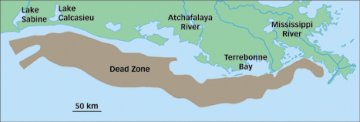
Science News
|
|
Things went from bad to worse when the juvenile ichthyosaur became sick or was attacked, and was left for dead on the seabed.
|
Nearly 110 million years later its fossilised skeleton has been found in Queensland, Australia, and that tiny tooth has become a vital clue for scientists.
For many years now, an annual dead zone has developed in the Gulf, beginning as early as February and sometimes lasting until mid-fall. This zone—water where the oxygen content is so low that denizens can’t survive—tends to leave no surface clue.
Although the precise timing and size of the Gulf’s dead zone varies with the weather, in many years it encompasses 22,000 square kilometers, a parcel of underwater real estate roughly the size of New Jersey. Fish that can evacuate as oxygen drops do so—although abandoning their home habitat may render them vulnerable to predators. Crustaceans and other seafloor life that can’t leave fast enough simply die.”
[Full Story]
“Methane ‘belch’ theory gets boost”
June 06, 2004, BBC Science News, UK: “Scientists have found a series of vents in the Nordic Seas that may have burped enough methane to cause massive global warming 55 million years ago.
The early Eocene Period witnessed a dramatic increase in temperature, which was triggered by a sudden surge of greenhouse gases in the atmosphere.
But just where these gases came from has been something of a mystery. Nature magazine reports the discovery of gas vents dating from the right time and which could represent the source.”
[Full Story]
“Satellite images ‘show Atlantis'”
June 06, 2004, BBC Science News, UK: “A scientist says he may have found remains of the lost city of Atlantis. Satellite photos of southern Spain reveal features on the ground appearing to match descriptions made by Greek scholar Plato of the fabled utopia.
|
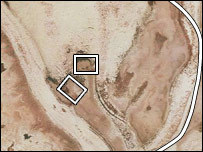
Rainer Kühne
|
|
Dr Rainer Kuehne thinks the “island” of Atlantis simply referred to a region of the southern Spanish coast destroyed by a flood between 800 BC and 500 BC.
The research has been reported as an ongoing project in the online edition of the journal Antiquity.
|
Satellite photos of a salt marsh region known as Marisma de Hinojos near the city of Cadiz show two rectangular structures in the mud and parts of concentric rings that may once have surrounded them.
‘Plato wrote of an island of five stades (925m) diameter that was surrounded by several circular structures – concentric rings – some consisting of Earth and the others of water. We have in the photos concentric rings just as Plato described,’ Dr Kuehne told BBC News Online.”
[Full Story]
“Lost city of Atlantis ‘found in Spain'”
June 08, 2004, The Daily Telegraph, UK: “Ancient ruins that appear to match Plato’s description of the fabled lost city of Atlantis have been found in southern Spain.
The structures, resembling two rectangular buildings at the centre of concentric circles, appear in satellite images of salt marshes near the port of Cadiz.
Rainer Kuehne, a German scientist who studied the images, says the ‘island’ of Atlantis was a region of Spanish coast ruined by a flood between 800 BC and 500 BC.”
[Full Story]
“Major shipwreck discovery in South Atlantic”
June 08, 2004, MercoPress, Uruguay: “A group of Argentine archaeologists have discovered the remains of a sunken vessel dating back to 1615, offshore the province of Santa Cruz in the Southern Atlantic.
Apparently the Dutch vessel ‘Hoorn’ belonged to an expedition that managed to discover the route joining the Atlantic and Pacific oceans.
According to Buenos Aires newspaper La Nación, the artefacts found close to Puerto Deseado belong to the oldest shipwreck ever found along the Argentine coastline.”
[Full Story]
“Shipwrecks cast new light on the Dark Ages”
June 09, 2004, The Times, UK: “Research has overturned centuries-old theories that the Dark Ages came soon after the turbulent decline of the Roman Empire in the 4th century AD.
Sean Kingsley, a British archaeologist, has drawn up a new map of 222 shipwrecks dating from the 4th to 10th centuries AD, which shows the emergence of a consumer revolution with an epicentre in the Holy Land.
The conclusions are dramatic, he said: ‘Rather than dying a quick death following the supposed decline of the Roman Empire, the Mediterranean Sea became a springboard for remarkably vibrant commercial trade.’“
[Full Story]
“Who moved Atlantis? Now it’s in Spain”
June 09, 2004, ABC News in Science, Australia: “The fabled lost city of Atlantis may lie in a salt marsh region off Spain’s southern coast, according to a German researcher.
His study, which is reported online by the archaeology journal Antiquity and has not yet been peer-reviewed by archaeologists, is based on the analysis of satellite images.
They show ancient ruins that the author says appear to match descriptions by the Greek scholar Plato.”
[Full Story]
“Ancient Treasure Ship to be Recovered from West Sea”
June 11, 2004, The Chosun Ilbo, South Korea: “The recent discovery of an ancient treasure ship off the southern coast of the Korean peninsula has many historians excited about the prospect of uncovering hundreds of priceless pieces of pottery dating back to more than a thousand years.
The vessel was discovered last fall and works are underway to salvage it out of the water. Efforts are in full swing to pull up an ancient ship that sank off the southwestern coast of the North Jeolla Province, carrying over 6,000 pieces of fine pottery.
The sunken vessel that was used to transport pottery during the Goryeo Dynasty, dating back more than to more than 1000 years is expected to offer a vast wealth of information on the maritime transportation system and the shipbuilding techniques of ancient times.”
[Full Story]
“Sunken treasure brings tidal wave of trouble”
June 13, 2004, IOL/The Sunday Independent, South Africa: “Once it was pirates who fought over hidden treasure. Now it is Mozambican archaeologists, jurists, government officials and businessmen doing the fighting.
Until recently the treasure in question was lying at the bottom of the Indian Ocean, in the bay of Ilha de Moçambique, in a Portuguese galleon sunk in the second half of the 16th century.
The galleon was on its way home from China when it sank. It was carrying untold treasures, most of which were looted in the distant past.”
[Full Story]
“Archeologist Claims Spanish Site for Atlantis”
June 16, 2004, The Epoch Times, China: “According to research reported by archaeology journal Antiquity, the fabled lost city of Atlantis could have been found in a salt marsh region off Spain’s southern coast.
|
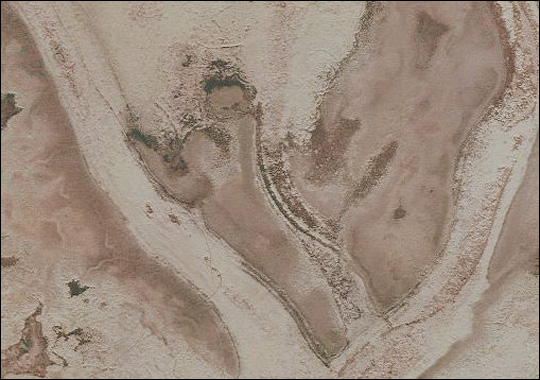
Rainer Kühne
|
|
The study, not yet peer-reviewed, is based on satellite images showing ancient ruins that seem to match descriptions made by the Greek scholar Plato, Discovery News reported.
Rainer Kuhne, a German scientist at the University of Wuppertal in Germany, says the description of Atlantis as an “island” simply refers to this part of Spain, which was destroyed by a flood between 800 and 500 B.C.
|
Satellite photos of a salt marsh region known as Marisma de Hinojos near the city of Cadiz show two rectangular structures in the mud and parts of concentric rings that may once have surrounded them.
Plato’s dialogues ‘Critias’ and ‘Timaios’ make mention of two rectangular features visible in the satellite image. These features are believed to be two temples, one of which is for the god Poseidon; the other, devoted to Cleito and Poseidon.”
[Full Story]
“Did comets flood Earth’s oceans?”
June 16, 2004, ESA News, France: “Did the Earth form with water locked into its rocks, which then gradually leaked out over millions of years? Or did the occasional impacting comet provide Earth’s oceans? The Ptolemy experiment on Rosetta may just find out …
The Earth needed a supply of water for its oceans, and the comets are large celestial icebergs – frozen reservoirs of water orbiting the Sun.
Did the impact of a number of comets, thousands of millions of years ago, provide the Earth with its supply of water? Finding hard scientific evidence is surprisingly difficult.”
[Full Story]
“North Sea birds dying as waters heat up”
June 20, 2004, The Observer, UK: “Until now their deaths have defied explanation. What caused hundreds of seemingly healthy seabirds to perish on the North Sea has baffled scientists since the discovery of their corpses on the Norfolk coastline this spring. Fears of a major pollution incident such as an oil slick were quickly dispelled.
But now the mystery is close to being solved and the answer has stunned ornithologists: the North Sea is heating up at an alarming rate. The broody expanse of water, famous for its violent storms and freak waves, is slowly being transformed.
Using the oldest maritime data in the world, scientists have found that climate change is ridding the North Sea of its precious stocks of plankton, the microscopic organisms on which all life in the sea depends. As the very building blocks of the food chain disappear, fish and the birds that feed on them, such as the puffin and guillemot, are starving to death in what has been their natural home for thousands of years.”
[Full Story]
“China salvages ancient sunken warship”
June 23, 2004, XinhuaNet, China: “Chinese archeologists are working to salvage a sunken warship of ancient naval general Zheng Chenggong, who took back Taiwan province from Dutch invaders more than 340 years ago.
Some 20 archeologists and dozens of divers will gather in the east China province of Fujian later this week to salvage the warship, hoping to unravel mysteries as to why the ship sunk and what weaponry and valuables were on board.
Zheng Chenggong’s warship sank in today’s Dongshan waters of the East China Sea, Fujian Province. In January 2000, two fishermen found pieces of a sunken ship inthe Dongshan waters. An initial salvage by archeologists subsequently produced a number of iron cannons, bronze blunderbusses, shells, landmines, damaged ship planks and porcelain at the site.”
[Full Story]
“Beach blob mystery solved at last”
June 27, 2004, New Scientist, UK: “‘An ocean without unnamed monsters,’ wrote John Steinbeck, ‘would be like sleep without dreams.’ But the dream that a new species of sea monster washed up in Chile in 2003 is over.
Marine biologists have definitively shown that the ‘Chilean Blob’ and other similar mysteries are simply the remains of whales.
In July 2003, a 13-tonne blob of amorphous tissue rolled ashore in Los Muermos, Chile. Local marine biologists could find no bones in it, prompting speculation that it might be the body of a new species of giant octopus.”
[Full Story]
“Under the sea, archaeologist hunts history of shipwrecks”
June 27, 2004, The Virginian-Pilot, USA: “The sea holds on. The Despatch lies in shallow water, but it’s rolling Atlantic water, and the divers who went looking for her this week had to feel their way around.
Susan Langley , underwater archaeologist for the state of Maryland , said that visibility in the murky water was only a few inches. Still, with the help of side-scan sonar and magnetic readings, it was enough for her to conclude that the wreck is worth protecting from collectors and treasure hunters, and she will recommend the same to the National Park Service and to Virginia.
Langley, her assistant and a team of volunteers dove on shipwrecks last week , a follow-up to last summer’s work in which they scanned more than 300 linear miles of ocean floor off Assateague Island.”
[Full Story]
|
|
To understand why this News Page is sometimes late here is some information about Fibromyalgia
if you would like to support our marine archaeology research
The Morien Institute
Research Projects
please send us a book

from our Wish List
…
exclusive
…
October 2002
Morien Institute
illustrated interview with
Professor Masaaki Kimura
of the University of the Ruykyus,
Okinawa, Japan, regarding
the discovery of:
“Megalithic structures found underwater off the coast of
Yonaguni-jima, Japan”
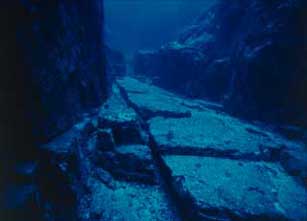
…
exclusive
…
June 2002
Morien Institute
illustrated interview with
Dr Paul Weinzweig
of Advanced Digital Communications,
Havana, Cuba, regarding
the discovery of:
“Megalithic urban ruins discovered off the coast of Cuba”
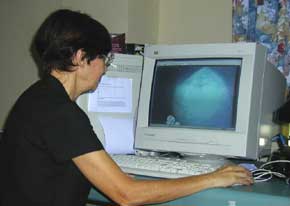
SeaLife
SL560 ReefMaster PRO
Set 35mm Camera
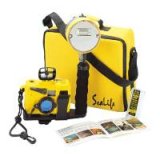
FEATURES:
Waterproof to 164 feet
35mm wide-angle lens
Triple-element lens construction
Push-button operation
Comes with SeaLife macro 3x close-up lens/underwater filter, SeaLife care kit, and external flash
“Atlantis of the West: The Case For Britain’s Drowned Megalithic Civilization”
by Paul Dunbavin
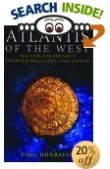
EU English Edition
“Do Welsh legends of lost cities beneath the sea match Plato’s descriptions of the island civilization of Atlantis? Do Irish myths of a golden age when the eastern Irish Sea was a flowery plain describe the same place Herodotus said disappeared beneath the waves during a single day and night of geological upheaval millennia before Ancient Greece?
Author and researcher Paul Dunbavin has embarked on a multidisciplinary investigation into how science could explain such a catastrophe and how modern archaeological findings point to a possible location for lost Atlantis. This book theorizes that the Middle Neolithic period around 5,000 years ago was a time of dramatic climate and sea-level changes all around the world.
From an up-to-date scientific perspective, Dunbavin distills an array of significant geological theories and then examines the archaeological and mythological record-which together leads to a lost land thousands of years ago in the Irish Sea that was still mentioned in ancient Welsh histories recorded in the 6th century.”
“Eden in the East: The Drowned Continent of Southeast Asia”
by Stephen Oppenheimer

EU English Edition
“A book that completetly changes the established and conventional view of prehistory by relocating the Lost Eden – the world’s 1st civilization – to SouthEast Asia. At the end of the Ice Age, SouthEast Asia formed a continent twice the size of India, which included Indochina, Malaysia, Indonesia and Borneo.
The South China Sea, the Gulf of Thailand and the Java sea, which were all dry, formed the connecting parts of the continent. Geologically, this half sunken continent is the Shunda shelf or Sundaland.
He produces evidence from ethnography, archaeology, oceanography, from creation stories, myths and sagas and from linguistics and DNA analysis, to argue that this founder civilization was destroyed by a catastrophic flood, caused by a rapid rise in the sea level at the end of the last ice age.”
“Discovery of Atlantis: Startling New Evidence and the Case for Cyprus”
by Robert Sarmast
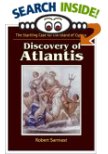
EU English Edition
“Plato provided 53 physical clues in his famous dialogue Critias–the original account of the story of Atlantis that is the sole basis of all Atlantis research.
Discovery of Atlantis proves that the island of Cyprus and the underwater landscape just south of Cyprus is a perfect match with 51 of these clues. Exclusive 3D bathymetric maps based on new scientific data show for the first time a stretch of sunken land off of Cyprus.
The general layout of the landscape of Atlantis as described by Plato is easily discernible on this underwater landmass, as well as the precise location of its capital–Atlantis City. This robust empirical data is joined with other original findings based on mythological analysis and historical research, making the case for Cyprus increasingly obvious.”
“Underworld: The Mysterious Origins of Civilization”
by Graham Hancock
&
Santha Faiia
(Photographer)

EU English Edition
“From Graham Hancock, bestselling author of Fingerprints of the Gods, comes a mesmerizing book that takes us on a captivating underwater voyage to find the ruins of a lost civilization that’s been hidden for thousands of years beneath the world’s oceans.
While Graham Hancock is no stranger to stirring up heated controversy among scientific experts, his books and television documentaries have intrigued millions of people around the world and influenced many to rethink their views about the origins of human civilization. Now he returns with an explosive new work of archaeological detection.
In Underworld, Hancock continues his remarkable quest underwater, where, according to almost a thousand ancient myths from every part of the globe, the ruins of a lost civilization, obliterated in a universal flood, are to be found.”
“Atlantis and Earth’s
Shifting Crust”

VHS NTSC version
(USA and Canada)
“Searching for Lost Worlds: Atlantis”

VHS NTSC version
(USA and Canada)
“Quest for the Lost Civilisation: Boxed Set”

VHS NTSC version
(USA and Canada)
VHS UK PAL version
(UK and Europe)
“SeaLife ReefMaster DC310 Digital MAXX 3.3MP Digital Dive Camera”
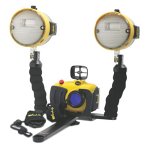
“The Atlantis Blueprint: Unlocking the Ancient Mysteries of a Long-Lost Civilization”
by Colin Wilson & Rand Flem-Ath

EU English Edition
“The Great Pyramid. Stonehenge. Machu Picchu. For centuries, these and other sacred sites have inspired wonder among those who ponder their origins.
Conventional science tells us they were constructed by local peoples working with the primitive tools of a fledgling civilization. Who could have built these elaborate monuments? How did they do it? And what were their incomprehensible efforts and sacrifices designed to accomplish? Now comes a revolutionary theory that connects these mysteries to reveal a hidden global pattern–the ancient work of an advanced civilization whose warnings of planetary cataclysm now reverberate across one hundred millennia.
International bestselling author Colin Wilson and Canadian researcher Rand Flem-Ath join forces to share startling evidence of a fiercely intelligent society dating back as much as 100,000 years–one that sailed the oceans of the world, building monuments to preserve and communicate its remarkable wisdom.”
“When the Sky Fell:
In Search of Atlantis”
by Rose & Rand Flem-Ath

EU English Edition
“Did Atlantis really exsist? If so,where was it,and what happened to it?
Inspired by the theory that at various stages in prehistory the earths crust shifted dramatically,causing violent earthquakes, tidal waves,devastating climatic changes,the authors examine the clues as to the location of Atlantis entrusted to Plato by Egyptian priests,the extraordinary similarities between myths from around the world,and ancient and amazingly accurate maps of South America and ice free Antarctica that date long before the first European explorers ever reached those shores.
They conclude that a civilization of highly intelligent seafarers did exists some twelve thousand years ago, but was destroy ed,by a geological disaster,leaving only a few survivors to safeguard its relicsand legends for posterity.”
“Atlantis, the Antediluvian World”
by Ignatius Donnelly
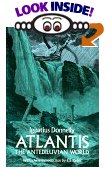
EU English Edition
“The most important book of its time (1882) on the subject of Atlantis.
The author claims there once existed in the Atlantic Ocean, opposite the mouth of the Mediterranean Sea, a large island, which was the remnant of an Atlantic continent, and known to the ancient world as Atlantis, that Atlantis was the region where man first rose from a state of barbarism to civilization, that the gods and goddesses of the ancient Greeks, the Phoenicians, the Hindus, and the Scandinavians were simply the kings, queens, and heroes of Atlantis, that the mythologies of Egypt and Peru represented the original religion of Atlantis, which was sun-worship, etc., etc. Illustrated with photographs.”
“The Round Towers
of Atlantis”
by Henry O’Brien

EU English Edition
“First published in 1834 as “The Round Towers of Ireland” or the “Mysteries of Freemasonry, of Sabaism, and of Budhism”, this book was an instant sensation as one of the first modern studies of Atlantis, round towers, pre-Christian megalithic architecture and secret societies.
In addition to being a sourcebook on Atlantis Research, Druidic Culture and origins of modern Celtic Christianity, the book is a treasure-trove of ancient esoteric lore and arcane knowledge of the past, including:
The History of the Tuath-de-Danaans, The Round Towers and Megalithic Crosses of Ireland are pre-Christian, Ireland’s strange connections with ancient India, Persia and China, Ancient Secret Societies and Ireland, Ancient Egyptians and Ireland, Pre-Christian Messiahs, Mithraism, and Ireland, The Connections Between Atlantis and Ireland.”
“Basic Decompression Theory and Application, Second Edition”
by Bruce R. Wienke

EU English Edition
“The new 2nd Edition of Basic Decompression Theory And Application has been extended, updated, with new material added. It takes all rudiments of decompression theory and phase mechanics to considerable depth, while focusing on diving applications in an historical perspective.
Topics span many disciplines, and the targeted audience is the commercial diver, hyperbaric scientist, doctor, physical scientist, technical diver, and instructor. Recent developments in diving tables, decompression meters, and decompression management software are presented, and broad model underpinnings are detailed and contrasted.
Testing and validation of modern dual phase approaches to staging for decompression, extended range, altitude, and mixed gas diving are a focus of discussion. Deep stops, optimal gas switches, and helium mixes are underscored from diver experience, data, and coarse grain principles. References and numerical examples (with solutions) are included for more detail and extended diver analysis.”
“Plato’s Timaeus”
by Peter Kalkavage (Translator)

EU English Edition
“A new translation in the Focus Philosophical Library series, with notes and introductory material, glossary and appendix.
Especially noteworthy are the extensive discussions in appendices on astronomy, geometry and music. Modern Students can now appreciate the wisdom of the world’s greatest thinkers.
Through clear, faithful translations, renowned scholars have made classical philosophical texts accessible and inspirational.”
“The Atlantis Dialogue: Plato’s Original Story of the Lost City, Continent, Empire”
by Plato, Aaron Shepard (Editor), B. Jowett (Translator)

EU English Edition
“Atlantis was first introduced to world literature by the Greek philosopher Plato in two “dialogues” he wrote in the fourth century B.C.
His tale of a great empire that sank beneath the waves has sparked thousands of years of debate over whether Atlantis really existed. But did Plato mean his tale as history, or just as a parable to help illustrate his philosophy?
In this book, you’ll find everything Plato said about Atlantis, in the context he intended. Now you can read and judge for yourself!”
“The New View over Atlantis”
by John F. Michell

EU English Edition
“The View Over Atlantis, John Michell’s unrivaled introduction to megalithic science, earth mysteries, and the inner meaning of number and measure, was described by Colin Wilson as ‘one of the great seminal books of our generation—a book which will be argued about for decades to come.’
Across much of the globe are ancient earthworks and stone monuments built for an unknown purpose. Their shared features suggest that they were originally part of a worldwide system, and John Michell argues that they served the elemental science of the archaic civilization that Plato referred to as Atlantis.
In this connection the most significant modern discovery is that of ‘leys’, the mysterious network of straight lines that link the ancient places of Britain and have their counterparts in China, Australia, South America, and elsewhere.”
“Successful Underwater Photography”
by Brian Skerry & Howard Hall
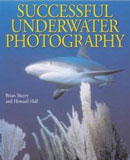
EU English Edition
“From fundamental principles of photographing marine life to making a living selling underwater photographs, Successful Underwater Photography provides an unlimited wealth of practical advice, surefire strategies, and tested tips for taking extraordinary photos of elusive underwater subjects.
Written by two top photographers who specialize in marine photography, this solid, lavishly illustrated field guide provides no-nonsense information on such topics as taking available-light photographs, silhouettes, marine wildlife portraits, close-focus wide angle photographs, and extension tube photographs to name just a few. Readers will also find proven guidance for purchasing underwater photographic equipment, taking photos of shipwrecks, and repairing and maintaining field equipment.
“Digital Imaging for the Underwater Photographer”
by Jack Drafhal & Sue Drafhal
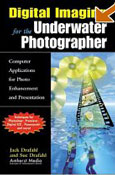
EU English Edition
“How to Solve Common Problems, Repair Images and Create Dazzling Presentations; Focusing on the aspects of digital imaging that are most important to underwater photographers, this book is a step-by-step guide for the professional and amateur alike to improve their images and presentations. Designed to help the underwater photographer make a smooth transition to digital imaging, this book discusses how to digitally refine, correct, and enhance underwater photographs. Detailing the equipment necessary, it also includes a discussion on the essentials of scanning. There is also extensive information on Adobe Photoshop, and how it can be used to edit underwater pictures.
Designed to help the underwater photographer make a smooth transition to digital imaging, this book discusses how to digitally refine, correct, and enhance underwater photographs. Detailing the equipment necessary, it also includes a discussion on the essentials of scanning. There is also extensive information on Adobe Photoshop, and how it can be used to edit underwater pictures.
SeaLife
DC310 3.3MP
Underwater Digital Camera

FEATURES:
Land Mode, Sea Mode and External Flash Mode
Instant delete option after each picture in both Sea and External Flash Modes
One-button operation
Expandable with all ReefMaster lenses, flashes and accessories
Depth tested to 200 ft / 60 m
“Maritime Archaeology: A Technical Handbook”
Jeremy Green
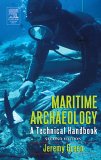
EU English Edition
“Jeremy Green’s systematic overview of maritime archaeology offers a step-by-step description of this fast-growing field. With new information about the use of computers and Global Positioning Systems, the second edition of this handbook shows how to extract as much information as possible from a site, how to record and document the data, and how to act ethically and responsibly wth the artifacts.
|


























